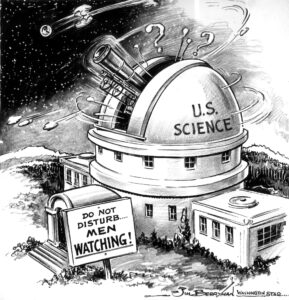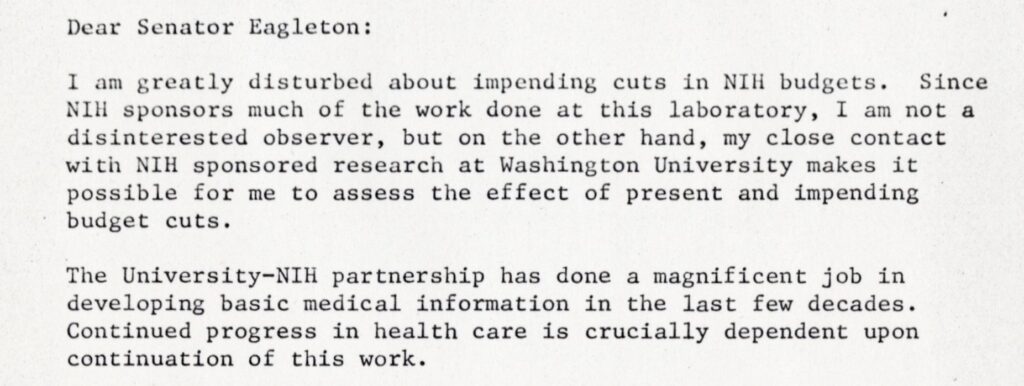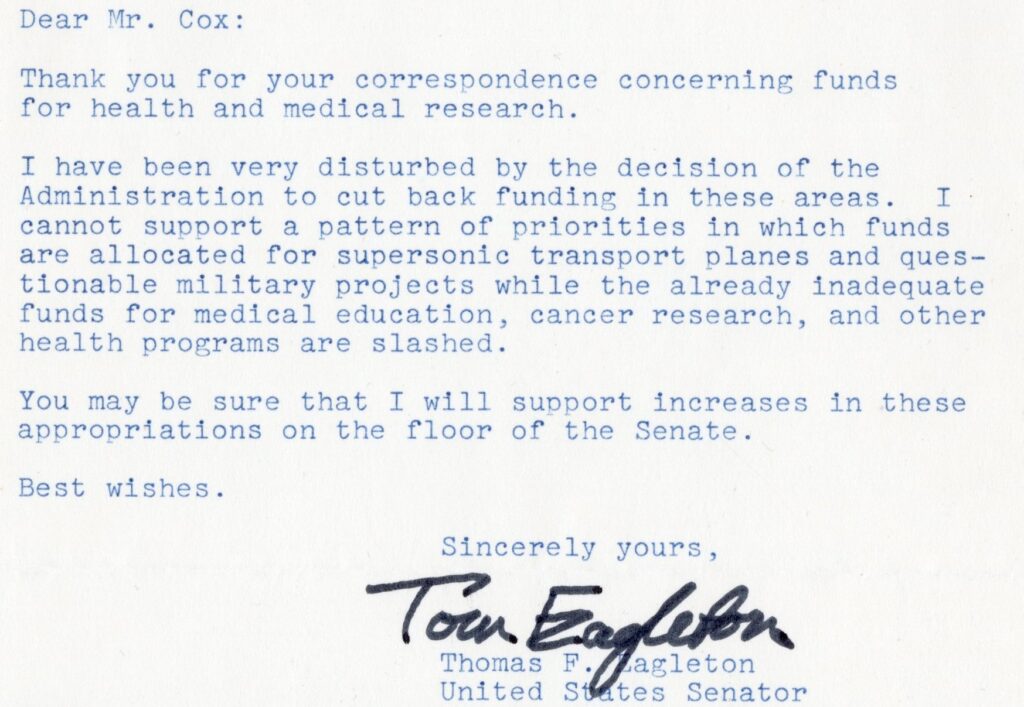
In February 1974, Dr. Jerome Cox, Jr., gave a speech at his alma mater, MIT, which asked, “Why Don’t We Have a Medical-Industrial Complex”? While the use of technology in medicine had certainly progressed since the 1950s, he suggested “a gap exists between expectations and accomplishments,” noting “[t]hings haven’t moved as they have in the defense sector.” Cox went on to say that, absent an ARPA-like agency for health, research on medical technology seemed to have been lost in the bureaucracy of the Department of Health, Education, and Welfare.[1]
What were some of the factors that led to this assessment of the past two decades? How did they influence biomedical computing at Washington University? And what does Sputnik have to do with it?

In the early hours of October 4, 1957, Severo Ornstein and his colleagues at MIT’s Lincoln Laboratory gathered to watch the Soviet Union’s launch of Sputnik. The first artificial satellite rose “together, as it turned out, with our job security,” Ornstein recalls in his memoir.[2] During the Cold War, the United States invested billions of dollars in science and technology research and development. The application of computing to biomedicine also originates in this period, concurrent with a rise in public and private support for medical research.[3]
Sputnik’s launch helped spur at least two developments that influenced the trajectory of biomedical computing. One was the allocation of over $50 million in emergency funding to the National Institutes of Health (NIH) explicitly for introducing computers to biomedical research. NIH Director James Shannon used the opportunity to lobby Congress for such funding, arguing the investment would advance both healthcare and science.[4] Less explicitly health-related, but no less significant, Sputnik also hastened the establishment of the Department of Defense’s Advanced Research Projects Agency (ARPA) in 1958. ARPA (later DARPA) was authorized to fund applied research and to create the facilities necessary to conduct such projects, including computer-related activities.

While NIH grants—like the one that supported the Washington University Computer Laboratories (WUCL) from 1967-1983—were a primary funding source, defense spending also shaped the course of biomedical computing in direct and indirect ways. In 1961, for example, upon learning of his Lincoln Lab colleague Wesley A. Clark’s interest in applying computers to neurophysiological research, Ornstein was pleased to find “a way to do something with computers in a totally different, non-military arena.”[5] A year later, when the NIH pledged support for a program to develop and evaluate the LINC—which stood for Laboratory INstrument Computer—Ornstein recalls that “Lincoln management, accustomed to the more generous overhead allowances of its military funders, was unwilling to deal with a new set of sponsors.”[6] After moving initially from Lincoln Lab to the main MIT campus, the LINC project and many of its personnel, including Clark and Ornstein, ultimately moved from MIT to Washington University in 1964, where the work continued in the Computer Research Laboratory (CRL).

More directly, research on macromodular computer systems within CRL—which became the Computer Systems Laboratory (CSL) in 1967—was supported by an ARPA grant. Though the scope of the research extended beyond medicine, CSL collaborated with the School of Medicine’s Biomedical Computer Laboratory (BCL) on the uses of macromodules in biomedical computing. In 1969, Charles Molnar, then Associate Director of CSL, shared with William F. Raub, chief of the Biotechnology Resources Branch in the Division of Research Resources at NIH, a summary of health-related areas to which macromodules could be applied. Molnar went on to outline how macromodular computer systems could aid in the manipulation and display of molecular models, neural modeling, biophysics of the auditory system, and computer analysis of microscope images.[7]
While some NIH personnel remained skeptical of biomedical computing, congressional concern over perceived reluctance among biologists and physicians to utilize computers—and thus keep up with the Soviet Union—helped secure funding in the early to mid-1960s. Increases took place in the context of the NIH’s already expanding budget, which grew from $52 million to $292 million in the 1950s. By the mid-1960s, NIH’s budget topped $1 billion. Yet despite this rise in funding, federal support for biomedical computing proved inconsistent as the 1960s progressed, especially as the costs of the war in Vietnam began to mount.[8]

As director of BCL from 1964-1975, Cox consistently called attention to the importance of funding biomedical research and computing. In 1966, he wrote to Presidential Science Advisor Donald Hornig to urge “substantial additional federal support of a new area of science”—university computation centers. Cox was motivated not only by his own research interests, but also by his recognition that scientists in fields from physics to oceanography were turning to digital computers with a fervor that would only continue to grow. Two years later, Cox alerted Senator Stuart Symington (MO) that gains made in medical research would “suffer serious setbacks” if proposed funding cuts to the Public Health Service and NIH proceeded. And in 1969, he wrote again to Senator Symington, as well as to Senator Thomas Eagleton (MO), to express concern about looming budget cuts to NIH, while highlighting how partnerships between universities and the NIH had resulted in substantial progress in health care over the past decade. In response, Senator Eagleton registered his own opposition, writing, “I cannot support a pattern of priorities in which funds are allocated for supersonic transport planes and questionable military projects while the already inadequate funds for medical education, cancer research, and other health programs are slashed.”[9]

In his 1974 speech, Dr. Cox acknowledged that, like the military-industrial complex President Eisenhower cautioned against in his 1961 farewell address, a medical-industrial complex may “have its flaws.” At the same time, he wondered “what would have happened if the power of the physical sciences and engineering had with equal vigor been turned toward medical goals for those three decades.”[10] Interestingly, in 2022, a new federal agency was established: ARPA-H. Modeled on DAPRA’s approach to research and innovation, ARPA-H is meant to support biomedical and health-related research. One cannot help but wonder what Dr. Cox, who once pondered “a health equivalent of ARPA,” would think of it.
Sources
Jerome R. Cox Papers, Bernard Becker Medical Library Archives, Washington University in St. Louis.
Institute for Biomedical Computing Records, Bernard Becker Medical Library Archives, Washington University in St. Louis.
Löwy, Ilana. “Historiography of Biomedicine: ‘Bio,’ ‘Medicine,’ and In Between.” Isis 102, no. 1 (2011): 116–22. doi: 10.1086/658661.
November, Joseph. Biomedical Computing: Digitizing Life in the United States. Baltimore: Johns Hopkins University Press, 2012.
Ornstein, Severo. Computing in the Middle Ages: a View from the Trenches, 1955-1983. Bloomington, IN: 1st Books Library, 2002.
Suran, Melissa. “New Federal Agency for Biomedical and Health Research.” JAMA 327, no. 20 (2022): 1949. doi: 10.1001/jama.2022.8175.
[1] Jerome R. Cox Papers, Bernard Becker Medical Library Archives, Washington University in St. Louis.
[2] Severo Ornstein, Computing in the Middle Ages: a View from the Trenches, 1955-1983 (Bloomington, IN: 1st Books Library, 2002), 47.
[3] Ilana Löwy, “Historiography of Biomedicine: ‘Bio,’ ‘Medicine,’ and In Between.” Isis 102, no. 1 (2011): 117-18.
[4] Joseph November, Biomedical Computing: Digitizing Life in the United States (Baltimore: Johns Hopkins University Press, 2012), 7; 79.
[5] Ornstein, Computing in the Middle Ages, 102.
[6] Ornstein, Computing in the Middle Ages, 113.
[7] Jerome R. Cox Papers, Bernard Becker Medical Library Archives, Washington University in St. Louis.
[8] November, Biomedical Computing: Digitizing Life in the United States, 15; 69-71; 79-80.
[9] Jerome R. Cox Papers, Bernard Becker Medical Library Archives, Washington University in St. Louis.
[10] Jerome R. Cox Papers, Bernard Becker Medical Library Archives, Washington University in St. Louis.
